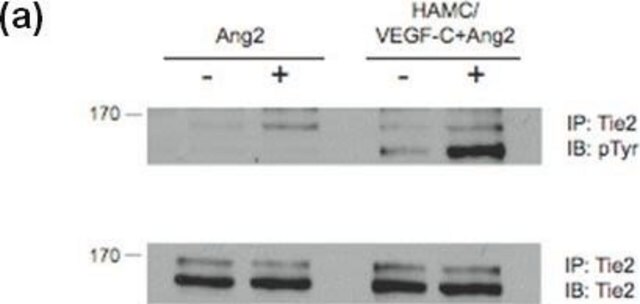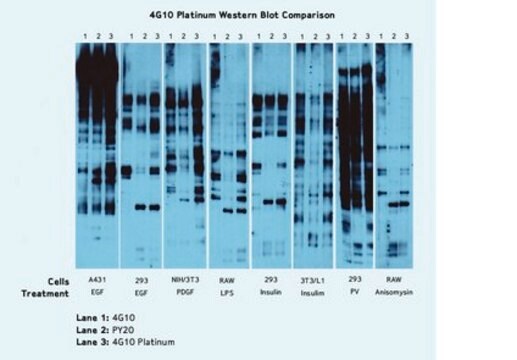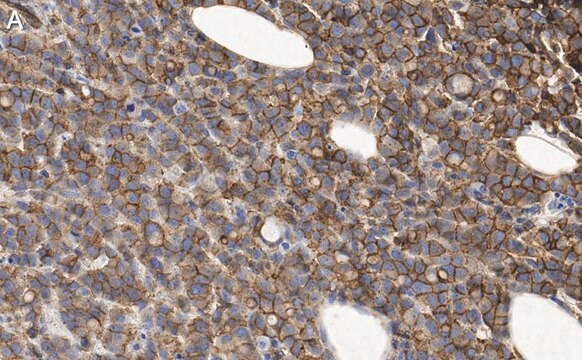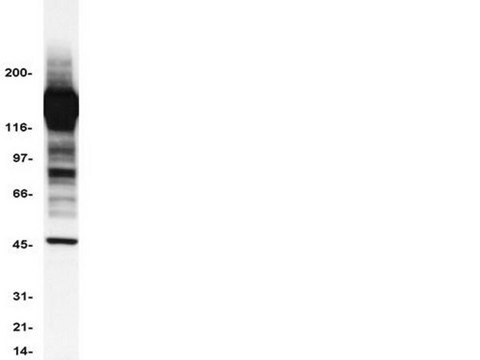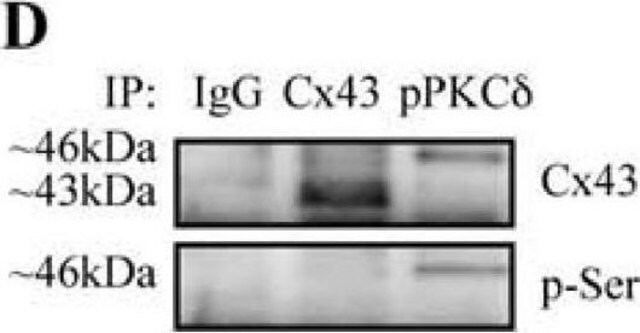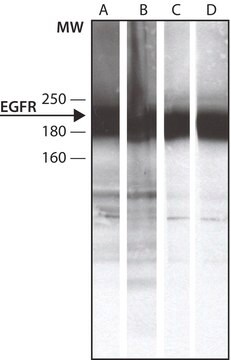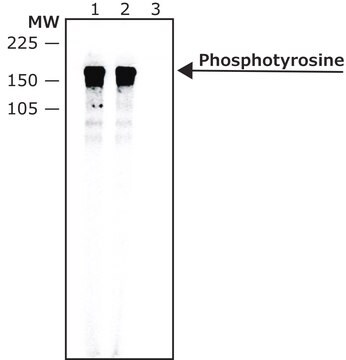05-321X
Anti-Phosphotyrosine Antibody, clone 4G10®
clone 4G10®, Upstate®, from mouse
Synonim(y):
Clone 4G10 Anti-Phosphotyrosine, Phosphotyrosine Detection Antibody
About This Item
Polecane produkty
pochodzenie biologiczne
mouse
Poziom jakości
forma przeciwciała
purified immunoglobulin
rodzaj przeciwciała
primary antibodies
klon
4G10®, monoclonal
reaktywność gatunkowa
vertebrates
producent / nazwa handlowa
Upstate®
metody
immunocytochemistry: suitable
immunohistochemistry: suitable
immunoprecipitation (IP): suitable
western blot: suitable
izotyp
IgG2bκ
Warunki transportu
wet ice
docelowa modyfikacja potranslacyjna
phosphorylation (pTyr)
Opis ogólny
The advent of anti-phosphotyrosine antibodies is one of significant events in signal transduction research. Before the availability of anti-phosphotyrosine antibodies, tyrosyl phospyhorylation of proteins and enzymes was investigated through hazardous and time-consuming radioactive experiments. Anti-phosphotyrosine antibodies are commonly used in western blots after the targeted proteins have been immunoprecipitated to measure the tyrosyl phosphorylation of the proteins. Anti-phosphotyrosine antibodies are also directly used on cell lysate to examine the overall change of tyrosine phosphorylation level in reponse to various treatments.
Specyficzność
Immunogen
Zastosowanie
2-4 μg of a previous lot immunoprecipitated quantitatively the phosphotyrosine containing proteins in the lysate of a confluent culture (10 cm dish) of cells expressing an activated tyrosine kinase. To preserve phosphotyrosine, add: 0.2 mM sodium orthovanadate to the lysis buffer.
Signaling
General Post-translation Modification
Jakość
Western Blot Analysis:
0.5-2 μg/mL of this lot detected tyrosine-phosphorylated proteins in a modified RIPA lysate from EGF-treated human A431 carcinoma cells (Cohen, B., 1990; Druker, B. J.,1989; Kanakura, Y., 1991).
Opis wartości docelowych
Postać fizyczna
IgG2bκ mouse monoclonal antibody produced in vitro by mouse-mouse hybridoma 4G10 (FOX-NY [NS-1 derivative] myeloma x spleen cells).
Przechowywanie i stabilność
NOTE: DO NOT FREEZE.
For maximum recovery of the product, centrifuge the original vial prior to removing the cap. If the product has accidentally been frozen and thawed, spin it at 13,000 x g for 10 minutes at 2-8ºC. Save the supernatant for application.
Komentarz do analizy
Positive Antigen Control: Catalog #12-302, EGF-stimulated A431 cell lysate. Add 2.5µL of 2-mercaptoethanol/100µL of lysate and boil for 5 minutes to reduce the preparation. Load 20µg of reduced lysate per lane for minigels.
Inne uwagi
Informacje prawne
Oświadczenie o zrzeczeniu się odpowiedzialności
Nie możesz znaleźć właściwego produktu?
Wypróbuj nasz Narzędzie selektora produktów.
polecane
Kod klasy składowania
12 - Non Combustible Liquids
Klasa zagrożenia wodnego (WGK)
nwg
Temperatura zapłonu (°F)
Not applicable
Temperatura zapłonu (°C)
Not applicable
Certyfikaty analizy (CoA)
Poszukaj Certyfikaty analizy (CoA), wpisując numer partii/serii produktów. Numery serii i partii można znaleźć na etykiecie produktu po słowach „seria” lub „partia”.
Masz już ten produkt?
Dokumenty związane z niedawno zakupionymi produktami zostały zamieszczone w Bibliotece dokumentów.
Klienci oglądali również te produkty
Nasz zespół naukowców ma doświadczenie we wszystkich obszarach badań, w tym w naukach przyrodniczych, materiałoznawstwie, syntezie chemicznej, chromatografii, analityce i wielu innych dziedzinach.
Skontaktuj się z zespołem ds. pomocy technicznej